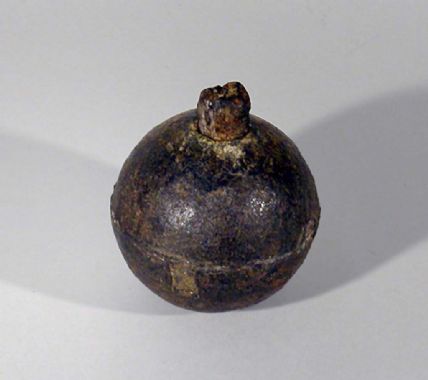As COVID-19 deaths spiked in 2020, Suzanne Firstenberg’s public art installation "In America: How could this happen…"
History Explorer Results (97)
Related Books (6)

Grade Range:
K-12
Resource Type(s):
Artifacts, Primary Sources
Date Posted:
12/16/2010
Physical Description
Light khaki jacket with blue facings with epaulettes and gold-colored buttons. Wool felt hat with cotton braids and gilt threads.
Specific History
Jacket and hat worn by Colonel Leonard Wood in Cuba.
While serving as an assistant su

Grade Range:
K-12
Resource Type(s):
Artifacts, Primary Sources
Date Posted:
12/15/2010
Blue wool uniform coat, gold-colored buttons on jacket front and sleeves. Epaulettes and gold trim at neck and cuffs.
This coat adheres to the 1813 uniform regulations; single-breasted, of dark blue wool, four buttons placed lengthwise on the sleeves and skirts. A gold star is embr

Grade Range:
K-12
Resource Type(s):
Artifacts, Primary Sources
Date Posted:
12/15/2010
During the colonial period, cattle horns were used by woodsmen and by soldiers for storing gunpowder in a safe, dry place. The horns also became decorative objects as they were personalized by the owner. Makers carved names, initials, dates, flags, battles, and even full maps on the exterior of t

Grade Range:
5-12
Resource Type(s):
Artifacts, Primary Sources
Date Posted:
12/15/2010
The halberd was a versatile pole arm developed as an infantry weapon in the 13th century. It has an ax-like blade and a steel spike mounted on the end of a long shaft. By the time of the Seven Years War it was carried by sergeants as a symbol of rank and authority.

Grade Range:
5-12
Resource Type(s):
Artifacts, Primary Sources
Date Posted:
12/15/2010
On October 28, 1774, the Rhode Island General Assembly chartered the Newport Light Infantry as a voluntary association of local citizens. These citizens wanted to form a company to obtain better military training than the colonial militia provided. The infantry, 100 strong, demonstrated its patri

Grade Range:
5-12
Resource Type(s):
Artifacts, Primary Sources
Date Posted:
12/15/2010
Continental army uniform coat worn by Colonel Peter Gansevoort Jr. of the 3rd Regiment of the New York Continental Line. He wore this coat during his command of Fort Stanwix, New York, in 1777.

Grade Range:
5-12
Resource Type(s):
Artifacts, Primary Sources
Date Posted:
12/15/2010
Grenades of this type played an important part in the biggest naval battle of the Revolutionary War. The Bon Homme Richard under the command of Captain John Paul Jones entered into a battle with the British ship the Serapis. The Serapis was a much faster and heavier shi

Grade Range:
K-12
Resource Type(s):
Artifacts, Primary Sources
Date Posted:
12/13/2010
Blue, white, and red banner with an image of Admiral Dewey in center of white stripe, surrounded by laurels. “Admiral Dewey” in banner among the laurels, American flag, and a navy fleet admiral’s flag. “The Hero” in top blue stripe. “Of Manila” in bottom red stripe.
A

Grade Range:
K-12
Resource Type(s):
Artifacts, Primary Sources
Date Posted:
12/13/2010
Physical Description
Black felt, grosgrain ribbon, ostrich feathers, and gold cockade, which is a ribbon rose or knot.
Specific History
Admiral Dewey is often pictured wearing his chapeau bras.
General History
A chapeau bras is a type of hat made

Grade Range:
K-12
Resource Type(s):
Artifacts, Primary Sources
Date Posted:
12/13/2010
Physical Description
Blue wool coat with gold trim on cuffs. Cap with wool body and gold-colored band. Naval insignia.
Specific History
Service coat and cap worn by Captain Charles V. Gridley at the Battle of Manila Bay.
General History
An Annapo















